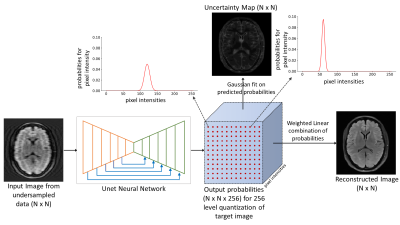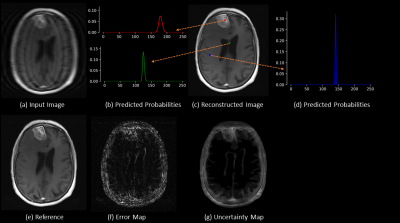Kamlesh Pawar1,2, Gary F Egan1,2,3, and Zhaolin Chen1,4
1Monash Biomedical Imaging, Monash University, Melbourne, Australia, 2School of Psychological Sciences, Monash University, Melbourne, Australia, 3ARC Centre of Excellence for Integrative Brain Function, Monash University, Melbourne, Australia, 4Department of Electrical and Computer Systems Engineering, Monash University, Melbourne, Australia
1Monash Biomedical Imaging, Monash University, Melbourne, Australia, 2School of Psychological Sciences, Monash University, Melbourne, Australia, 3ARC Centre of Excellence for Integrative Brain Function, Monash University, Melbourne, Australia, 4Department of Electrical and Computer Systems Engineering, Monash University, Melbourne, Australia
Image reconstruction
was modeled as a classification problem and the predicted probability of the reconstructed
pixel was used to estimate the uncertainty map. The predicted uncertainties correlate
with the actual errors, providing a tool for risk assessment of DL image
reconstruction.

Figure 1: A image obtained from the undersampled k-space data was used as input and a fully
sampled image quantized to 8-bit (256 grey levels) was used as target image to
the network for training. The DL Unet network classifies each pixel in the reconstructed image and the output of the network was probability for each pixel belonging to one
of the 256 distinct quantized grey levels. A weighted linear combination of the
predicted probability forms the reconstructed image and standard deviation of a
Gaussian fitted curve to the predicted probability distribution from the uncertainty
maps.

Figure 2: (a)
Input image from undersampled (factor of 4) k-space data; (b, d) are the
predicted probabilities at spatial location as pointed out by the red, blue and
green dots in the reconstructed image respectively; (c) Reconstructed image
obtained using weighted linear combination of the predicted probabilities; (e)
fully sampled reference image; ; (f) error image obtained by subtracting
reference and output image; (c) Uncertainty maps obtained from standard
deviation of the fitted Gaussian curve to the predicted probabilities.